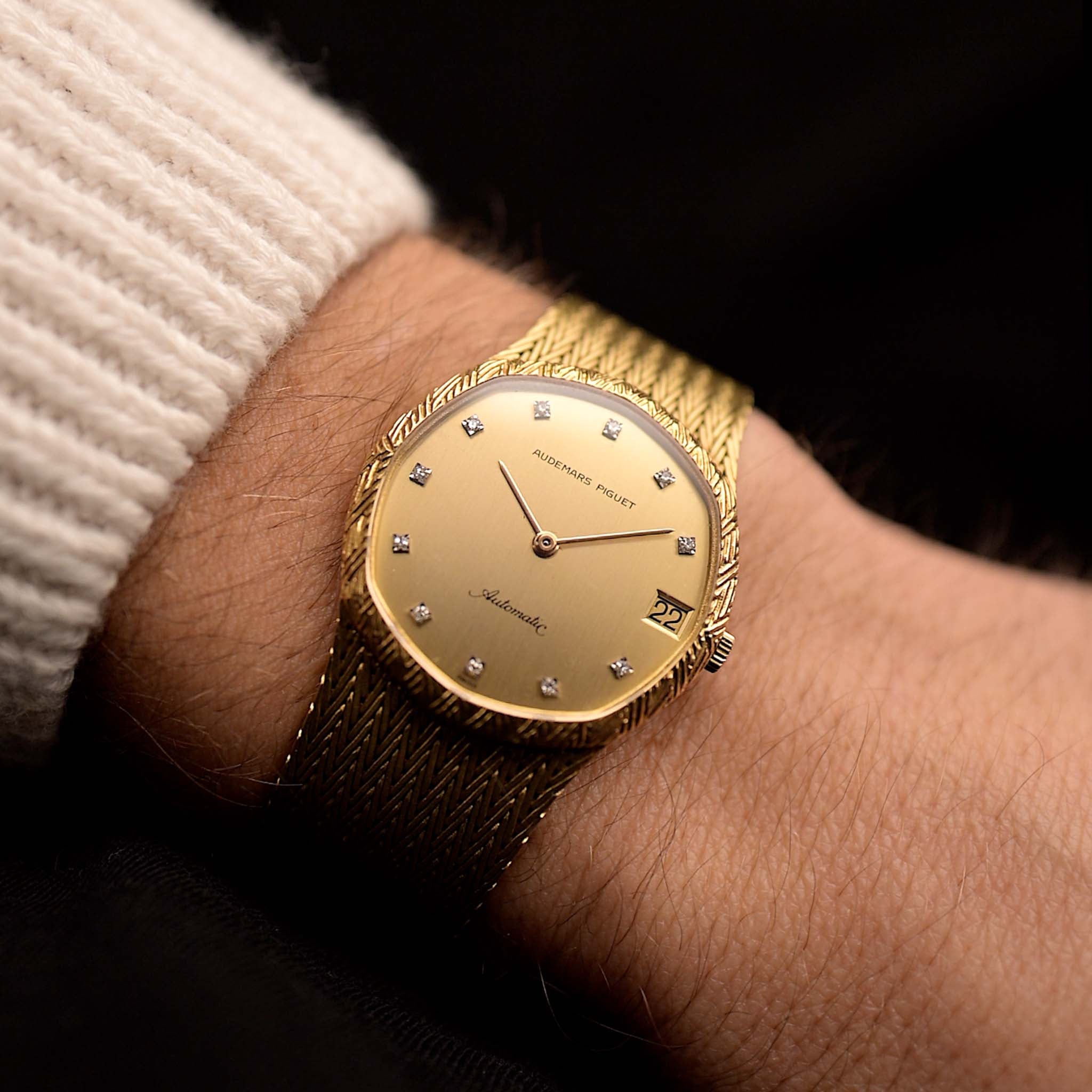This is the fifth part of this series and so far we have defined two handsome looking watches both very distinct and fitting perfectly into their respective time periods. However, there are certain features on a chronograph that make this complication so unique. Features, that make a chronograph look like a chronograph. And of course I'm speaking about the sub-dials, indicating the clocked seconds, minutes and possibly hours, and the bezel, which itself serves a central purpose on a chronograph.
November 09, 2021
What Makes a Chronograph Look Like a Chronograph?
 Marcus Siems @siemswatches
Marcus Siems @siemswatches
Collector, Author, Data Analyst
This is the fifth part of this series and so far we have defined two handsome looking watches both very distinct and fitting perfectly into their respective time periods. However, there are certain features on a chronograph that make this complication so unique. Features, that make a chronograph look like a chronograph.
And of course I'm speaking about the sub-dials, indicating the clocked seconds, minutes and possibly hours, and the bezel, which itself serves a central purpose on a chronograph. As always it's better to not only rely on a feeling when it comes to such a description but aid it with some evidence. I quantitatively analyzed over 4000 watches, including about 800 chronographs - publicly listed on chrono24[1] to add some numbers to the discussion.
 It's finally time to conclude our quest for the Golden Age of the Chronograph. Photo @goldammer.me
It's finally time to conclude our quest for the Golden Age of the Chronograph. Photo @goldammer.me
The bezel is the last barrier between your watch and the outside world, a small ring between dial and thin air. In many ways the bezel can augment your timepiece and even determine a watches raison d’être. Its style depends on whether it shall boost the elegance or the stylishness; whether it wants to show itself or blend in. But the truly underrated value is that this slender ring around the crystal can be highly functional.
The sub-dials are a bit more of a pragmatic detail. The movement inside defines if you can stop seconds, minutes or hours or even sport additional complications. However, this technological detail is as much a result of the time the chronograph is built in, as are all the other key design elements. What we will additionally look at is the total number of hands on the dial. This of course correlates with the number of sub-dials but gives an extra feeling about added features – every hand on the dial can be seen as an additional complication.
 Figure 5. Bezel style and hand count of the 1950 and 1970 chronograph. Until approximately 1960 the bezel has been used for visual pleasure only. Starting from then it was more and more served a purpose with for example tachymeter- and diver scales. The hand count shows a clear peak at 5 around 1950, indicating 2 sub-dials or clocked seconds and minutes. Later this distribution again shifts towards 5-6 hands in 1970, with a slight advantage for 6 hands.
Figure 5. Bezel style and hand count of the 1950 and 1970 chronograph. Until approximately 1960 the bezel has been used for visual pleasure only. Starting from then it was more and more served a purpose with for example tachymeter- and diver scales. The hand count shows a clear peak at 5 around 1950, indicating 2 sub-dials or clocked seconds and minutes. Later this distribution again shifts towards 5-6 hands in 1970, with a slight advantage for 6 hands.
Now we ended up with two fine chronograph examples. Both oozing the charm of their respective periods. Furthermore, we see, like it still seems today, the classic chrono dial has two to three sub-dials (five to six hands). Over time we see a clear shift in this layout. Generally, the earlier the chronograph the more likely you see five hands (two sub-dials) as opposed to six (three sub-dials). A distribution that can readily be explained by the movements and the relevant power reserve available at each time. However, some peculiarities occur in our two time periods.
Interestingly, several 1950 pieces exceed the six-hand line whereas around 1970 some pieces undershoot the five-hands. That’s a fascinating dissociation. As we’ve encountered before the 1950 chronograph is a complicated dress watch, and sometimes the chronograph complication is not enough[3,4]. As we can see for example with the iconic Datocompax models of several brands - on the forefront Universal Geneves Tri-Compax - a chronograph can be well paired with a perpetual calendar or a Moonphase indication and gain a lot of wow-factor.
 Heuer was certainly no stranger to the high-complication chronograph market - case and point by this stunning 1940s Chronograph with calendar. Photo @goldammer.me
Heuer was certainly no stranger to the high-complication chronograph market - case and point by this stunning 1940s Chronograph with calendar. Photo @goldammer.me
And that’s exactly why we see the opposite trend around 1970. As extraordinary as the design might seem to us nowadays the 1970 chronograph is functional to its core. So no chichi you’d rather see a stripped down version, only left with the essentials: A two-hand time-only dial and a central-seconds stopwatch complication. A version most commonly known from Omega as the Chronostop[5] - or from the mother of all wristwatch chronographs, the Longines 13.33Z[2]. It’s the perfect embodiment of its time, an easy-to-use chronograph with a seemingly extravagant exterior and a charming angle on the complication.
And this speed-driven vibe of the chronograph case can further be topped by the bezel of choice. And here the chronograph very often displays this one certain bezel that sets it apart from almost all other watches. I am of course speaking about the tachymeter scale. As the name implies it’s a watches function to clock speed by measuring the time it takes to travel one unit of distance. It’s in principle a non-mechanical function that any watch could satisfy but the tachymeter simplifies it by taking out all mental computations. Naturally, many chronograph watches adapted a tachymeter, or similar functional scales - the raison d’être for many applications.
 Three different types of functional Chronograph scales: the Tachymeter (left - Universal Geneve Compax), the Telemeter (middle - Longines Artdeco Chronograph) & the Pulsometer (right - Breitling Chronograph). Photos @goldammer.me
Three different types of functional Chronograph scales: the Tachymeter (left - Universal Geneve Compax), the Telemeter (middle - Longines Artdeco Chronograph) & the Pulsometer (right - Breitling Chronograph). Photos @goldammer.me
The scale is especially useful for any sort of racing and navigation at high speeds. In the middle of the last century tachymeter bezels start to appear[2,6,7], with for example Heuer’s rotating tachymeter bezel (1958) on the forefront of new developments. However, the tachymeter is not an invention of the late 1950s. It has been featured in chronograph watches ever since. In the early twentieth century you could often see a tachymeter printed onto the dial, later at the outer rim until finally the now common tachymeter bezel became popular[2].
So as you can see, even though the smooth bezel is most common in most chronograph watches until today, the tachymeter is still a feature on almost every stopwatch – either on the bezel or the dial.
 Around 1970 not as rare as one might think: A Chronograph with Dive Bezel - as seen here on this piece from Hanhart. Photo @goldammer.me
Around 1970 not as rare as one might think: A Chronograph with Dive Bezel - as seen here on this piece from Hanhart. Photo @goldammer.me
Looking back at all the details, the chronograph – a cornerstone of modern watchmaking – has truly evolved quite drastically. Every age has been putting its own twist on this well recognizable archetype. All the different sub-types, dial colors, case forms, bezels, hand-shapes, numbers and marker-styles, the chronograph is always dressing up age-appropriately. So now, what vintage chronograph do you want? The elegant 1950 piece with a subtle outer silhouette leaving the stage for all these beautiful mid-century dial variants? Or the groovy 1970 watch, a utility and activity inspired sports chronograph, with dark dials, playful cases, always surrounded by a daredevil atmosphere? The two ages are defining chronograph periods with a common denominator in their pieces but lastly diversity is key.
This characteristic piece of the horological world with over 100 years of history on the wrist has been the fuel for speed records, the star on the big screen, and the well-dressed companion to many galas. It is a complication that has been used as versatile as watch-design itself can be. And different to many other complications it is not just of visual pleasure – it is the haptic experience you have when you operate these pushers.
Not surprisingly, the chronograph is one of the – if not the – most sought after complication for collectors and definitely shaping our perception of the modern watch. Out of the 10 most expensive watches sold at auctions, five have been chronographs[8,9].
But the intriguing fact about the time-stopping mechanism is that it is not solely a high-end complication reserved for the wealthiest of collectors. It can be found in any price range. Every watch enthusiast can come into the pleasure of feeling the super powers of these extra pushers. It is this combination that makes the chronograph so special. Being so otherworldly by its history and heritage yet in the same moment so down to earth. It’s the reason this complication has become a watchmaking icon itself.
The Golden Age of the Chronograph
Part I - History
Part II - Elegance & Utility
Part III - Case Design
Part IV - The Dial
Part V - The Essence
References
[1] Watches from Chrono24, extracted 2020 Nov. 29th; Karlsruhe, Germany;
[2] The History of the Chronograph; Crown & Caliber;
https://blog.crownandcaliber.com/the-history-of-the-chronograph/
[3] Valjoux 72c VZHC; Genesis, Grail Watch Reference;
https://reference.grail-watch.com/movement/valjoux-72c/
[4] Valjoux 72: A Chronograph In A Million; Ben Kessler, Revolution Watch;
https://revolutionwatch.com/valjoux-72-a-chronograph-in-a-million/
[5] The Omega Chronostop; Dan Henry, Dan Henry Vintage Watches;
https://danhenrywatches.com/blogs/journal/the-omega-chronostop
[6] The beauty of a tachymeter; Erik Mak, DMC Watch;
https://dmc-watch.com/blogs/news/the-beauty-of-a-tachymeter
[7] An Overview Of A Tachymeter Watch: Do You Need One?; Kim Lee, The Watch Company TWC;
https://www.thewatchcompany.com/blog/tachymeter-watch/
[8] 11 Most Expensive Watches Sold At Auction In The Past 10 Years; Mia Forbes, The Collector;
https://www.thecollector.com/11-most-expensive-watches-sold-at-auction/
[9] List of most expensive watches sold at auction; Wikipedia;
https://en.wikipedia.org/wiki/List_of_most_expensive_watches_sold_at_auction
All rights on text and graphics reserved to the Author.




























Leave a comment